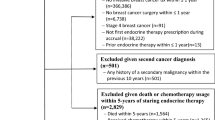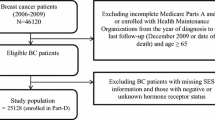Abstract
In spite of its demonstrated benefits, many women do not initiate hormonal therapy, and among those who do, many discontinue it prematurely. We examined whether differences in hormonal therapy adherence may be at least partially explained by the availability of prescription drug coverage. Women aged 20–79 years diagnosed with stage I-III breast cancer between June 2005 and February 2007 were enrolled in the study. Women completed a mailed survey, on average 9 months after diagnosis, and again approximately 4 years later (N = 712). Adjusted logistic regression was used to predict the likelihood of initiating hormonal therapy and hormonal therapy continuation. Women who had prescription drug coverage were more likely to initiate hormonal therapy relative to women without prescription drug coverage (OR 2.91, 95 % CI 1.24–6.84). Women with prescription drug coverage were also more likely to continue hormonal therapy (OR 2.23; 95 % CI 0.99–5.05, p = 0.0543). The lowest income women were also less likely to continue hormonal therapy relative to women with annual household income that exceeded $70,000 (OR 0.55; 95 % CI 0.29–1.04) with a borderline significance of (p = 0.08). This study demonstrates the critical role of prescription drug coverage in hormonal therapy initiation and continuation, independent of health insurance coverage. These findings add to the body of literature that addresses medication adherence. Financial factors must be considered along with behavioral factors that influence adherence, which is becoming increasingly relevant to oncology as treatments are shifted to oral medications, many of which are very expensive.
Similar content being viewed by others
References
Hershman DL, Greenlee H, Awad D et al (2013) Randomized controlled trial of a clinic-based survivorship intervention following adjuvant therapy in breast cancer survivors. Breast Cancer Res Treat 138(3):795–806
Makubate B, Donnan PT, Dewar JA et al (2013) Cohort study of adherence to adjuvant endocrine therapy, breast cancer recurrence and mortality. Br J Cancer 108(7):151–1524
McCowan C, Shearer J, Donnan PT et al (2008) Cohort study examining tamoxifen adherence and its relationship to mortality in women with breast cancer. Br J Cancer 99(11):1763–1768
Partridge A, Wang P, Winer E et al (2003) Non-adherence to adjuvant tamoxifen therapy in women with primary breast cancer. J Clin Oncol 21(4):602–606
Visvanathan K, Hurley P, Bantug E et al (2013) Use of pharmacologic interventions for breast cancer risk reduction: American society of clinical oncology clinical practice guideline. J Clin Oncol 31(23):2942–2962
American Cancer Society (2015) Hormonal therapy for breast cancer. http://www.cancer.org/cancer/breastcancer/detailedguide/breast-cancer-treating-hormone-therapy. Accessed 24 June 2015
Kimmick G, Anderson R, Camacho F et al (2009) Adjuvant hormonal therapy use among insured, low-income women with breast cancer. J Clin Oncol 27(21):3445–3451
Partridge AH, LaFountain A, Mayer E et al (2008) Adherence to initial adjuvant anastrozole therapy among women with early-stage breast cancer. J Clin Oncol 26(4):556–562
Lash TL, Fox MP, Westrup JL et al (2006) Adherence to tamoxifen over the five-year course. Breast Cancer Res Treat 99:215–220
Guy G, Lipscomb J, Gillespie T et al (2014) Variations in guideline-concordant breast cancer adjuvant therapy in rural Georgia. Health Serv Res. doi:10.1111/1475-6773.12269
Wu XC, Lund MJ, Kimmick GG et al (2012) Influence of race, insurance, socioeconomic status, and hospital type on receipt of guideline-concordant adjuvant systemic therapy for locoregional breast cancers. J Clin Oncol 30(2):142–150
Freedman R, Virgo K, He Y et al (2011) The association of race/ethnicity, insurance status, and socioeconomic factors with breast cancer care. Cancer 117(1):180–189
Hershman DL, Tsui J, Wright JD et al (2015) Household net worth, racial disparities, and hormonal therapy adherence among women with early-stage breast cancer. J Clin Oncol 33(9):1053–1059
Aizer AA, Falit B, Mendu ML et al (2014) Cancer-specific outcomes among young adults without health insurance. J Clin Oncol 32(19):2025–2030
Health and Human Services (2015) Key features of the affordable care act. http://www.hhs.gov/healthcare/facts/timeline/. Accessed 9 July 2015
Jagsi R, Pottow JA, Griffith KA et al (2014) Long-term financial burden of breast cancer: experiences of a diverse cohort of survivors identified through population-based registries. J Clin Oncol 32(12):1269–1276
Jagsi R, Hawley ST, Abrahamse P et al (2014) Impact of adjuvant chemotherapy on long-term employment of survivors of early-stage breast cancer. Cancer 120(12):1854–1862
Hawley ST, Jagsi R, Morrow M et al (2014) Social and clinical determinants of contralateral prophylactic mastectomy. JAMA Surg. doi:10.1001/jamasurg.2013.5689
Ekwueme DU, Yabroff KR, Guy GP Jr et al (2014) Medical costs and productivity losses of cancer survivors–United States, 2008–2011. MMWR Morb Mortal Wkly Rep 63(23):505–510
Neugut A, Subar M, Wilde ET et al (2011) Association between prescription co-payment amount ad compliance with adjuvant hormonal therapy in women with early-stage breast cancer. J Clin Oncol 29(18):2534–2542
Richardson L, Tian L, Voti L et al (2006) The roles of teaching hospitals, insurance status, and race/ethnicity in receipt of adjuvant therapy for regional-stage breast cancer in Florida. Am J Public Health 96(1):160–166
Kaiser Family Foundation (2015). http://kff.org/medicare/fact-sheet/the-medicare-prescription-drug-benefit-fact-sheet/. Accessed 9 July 2015
Acknowledgments
Author contribution
All authors had full access to the data and participated in the design, analysis, and interpretation of the data. Bradley was responsible for drafting the manuscript. All authors reviewed the manuscript before submission.
Funding
This project was funded by Grants R01 CA088370 and R01 CA109696 from the National Cancer Institute to the University of Michigan.
Author information
Authors and Affiliations
Corresponding author
Ethics declarations
Conflict of Interest
None of the authors have any potential conflicts of interest to disclose.
Rights and permissions
About this article
Cite this article
Bradley, C.J., Dahman, B., Jagsi, R. et al. Prescription drug coverage: implications for hormonal therapy adherence in women diagnosed with breast cancer. Breast Cancer Res Treat 154, 417–422 (2015). https://doi.org/10.1007/s10549-015-3630-x
Received:
Accepted:
Published:
Issue Date:
DOI: https://doi.org/10.1007/s10549-015-3630-x




